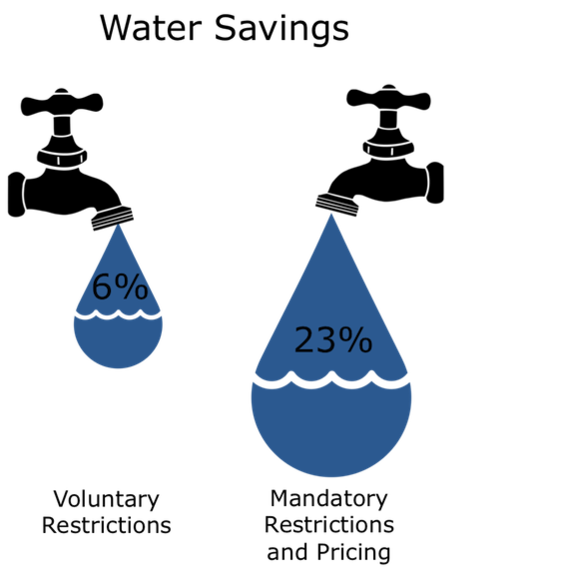By Kristen Holdsworth and Céline Kuklowsky
It seems that California Governor Jerry Brown's January 2014 plea for 20 percent water conservation has done little to actually reduce consumption across the state. According to a June State Water Resources Control Board report, Californians have decreased water use by just 5 percent. Dealing with limited water supply and drought conditions is not a new situation for Californians--we have been told to install low-flush toilets, run full loads of laundry, and water our lawns less for decades.
What will it take, then, for the state to actually reduce water consumption?
Today, the California Center for Sustainable Communities at UCLA released a policy brief based on an analysis of ten years of Los Angeles Department of Water and Power data that links water consumption to socio-economic demographics, climate information, and water prices.
The study finds there are four main factors that drive water consumption: household income, landscape greenness, water rates, and water volume allocation. Not surprisingly, household income is the biggest determinant of single-family residential water consumption. In fact, wealthier neighborhoods consume three times the amount of water than less affluent neighborhoods.
How is water used?
Southern California has come a long way in already reducing its water consumption, in large part due to its efforts after the drought in the late 1980s. An emphasis on conservation, coupled with rebates and incentives for low-flow showerheads, toilets, and other appliances helped the southern part of the state in subsequent dry spells.
However, there is still untapped potential. More than 50 percent of single-family residential water use across the city of Los Angeles is spent outdoors, according to the UCLA study. Pools and lush landscapes are largely to blame, as well as wasteful irrigation practices. Researchers found that the greatest water savings can be made in outdoor irrigation reduction. What's more, the study indicates that mandatory watering restrictions-such as limiting outdoor watering to two days a week-only slightly decreased overall landscape "greenness," indicating that people in LA are currently overwatering their landscapes.
Perhaps unsurprisingly, mandatory restrictions are much more effective at curbing water use (both indoors and outdoors) than voluntary ones. When the LADWP placed mandatory restrictions on water consumption in 2008 and 2009 and increased water rates, they saw a 23 percent reduction in water usage across the city. In comparison, previous voluntary restrictions had only resulted in a 6 percent reduction.
What does this mean for water prices?
Mandatory restrictions and increased water rates are not always politically feasible however, especially in difficult economic times. In Los Angeles, the new LADWP general manager Marcie Edwards and LA mayor Eric Garcetti have both vowed to restore the public's trust in the utility and not raise rates for the next year. There are many considerations for water agencies and policy makers in regards to rate increases, including creating a business-friendly environment and concerns of equity.
It is critical that California water agencies begin tackling water conservation by addressing the remaining "low hanging" fruit. Addressing outdoor watering through enhanced landscaping ordinances and turf removal programs is the first step, since this represents the largest use of single-family residential water consumption. The Metropolitan Water District of Southern California, like many other agencies, is offering enhanced rebates right now. As of this month, they increased the amount of money allocated for all water rebates, especially turf removal.
In the long-run, policy makers and residents will need to come to terms with increased water rates and revised billing structures. This may take several forms, including dual metering to differentiate between indoor and outdoor water use, transitioning to an increasing block rate structure that combines seasonal pricing to curb consumption during high demand months (similar to Salt Lake City's), or establishing water budgets where water is priced much higher when a user exceeds his or her allocated amount of water (such as those found in Orange County).
To learn more about policies for water conservation, view the full report here. Follow the California Center for Sustainable Communities at UCLA on Twitter: @CCSCatUCLA.
_____________
Both authors work at the California Center for Sustainable Communities at UCLA. Kristen Holdsworth is a project manager and oversees outreach and communication efforts. Céline Kuklowsky is a senior research associate. The findings discussed are based on collaborative research funded by the National Science Foundation ULTRA-EX Program and overseen by Dr. Stephanie Pincetl and Dr. Terri Hogue. Stephanie Pincetl is professor-in-residence at the UCLA Institute of the Environment and Sustainability and director of the California Center for Sustainable Communities at UCLA. Terri Hogue is associate professor in the civil and environmental engineering department and associate director of the Hydrologic Sciences and Engineering Program at the Colorado School of Mines.


